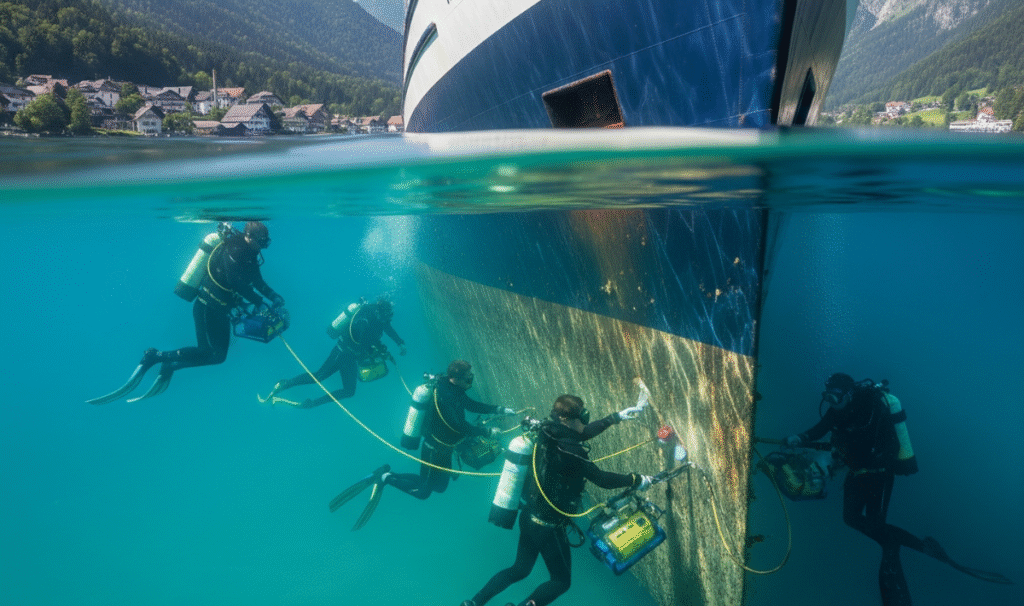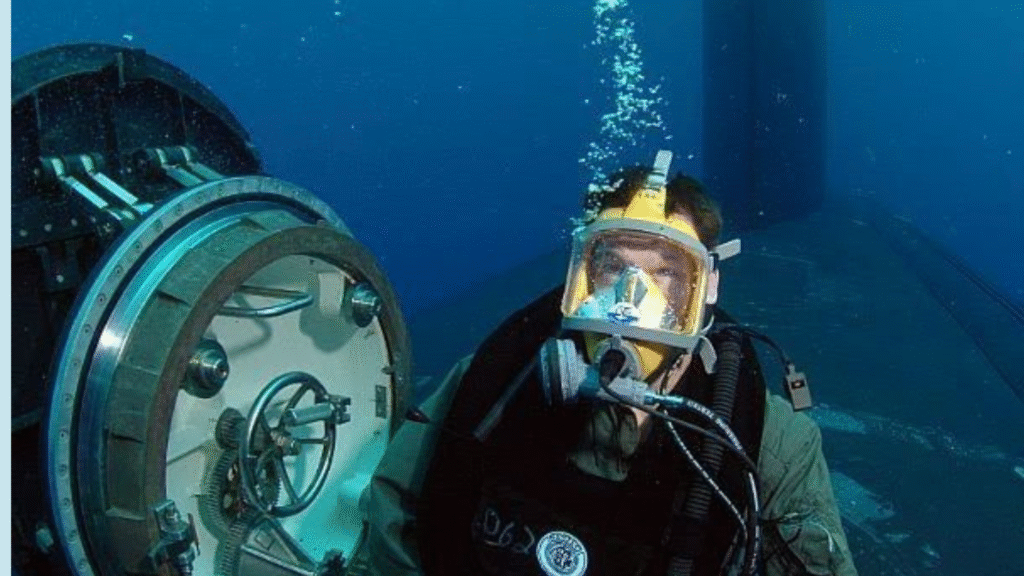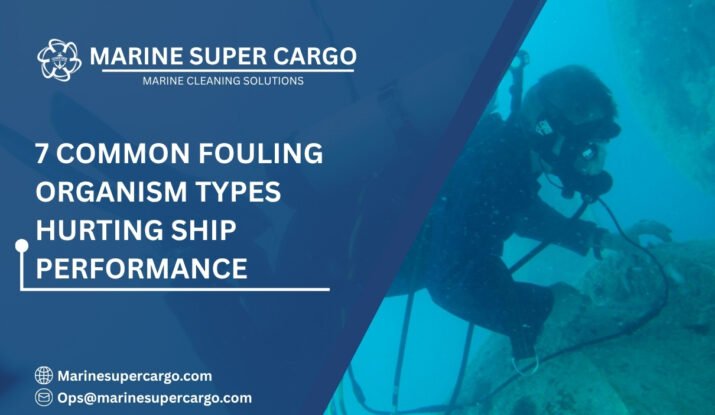Imagine sailing with invisible weights slowing you down at every turn—that’s what ships endure when fouling organisms cling to their hulls. These organisms increase drag, spike fuel consumption, and quietly drive up operating costs. For ship owners and operators, knowing the common fouling organism types is crucial for maintaining performance and efficiency.
In this guide, we’ll explore the seven most common species that infest ship hulls, explain why they impact speed and fuel usage, and highlight proven solutions to keep these hidden threats under control.
Why Study Fouling Organisms?
Hull biofouling isn’t just about a dirty ship. It’s a multi-billion-dollar problem with global impacts:
- Up to 40% rise in fuel bills if fouling is left unchecked.
- Higher greenhouse emissions risk breaches of MARPOL Annex VI.
- Greater potential for invasive species transfer, flagged by IMO.
- Shortened coating life, leading to premature drydocking.
When we identify fouling organism type, we can match cleaning strategies, optimize coatings, and meet regulatory expectations with confidence.
The Two Big Categories of Biofouling
Biofouling, the accumulation of unwanted marine organisms on a ship’s hull, can be broadly divided into microfouling and macrofouling. Understanding these categories is crucial for effective maintenance and fuel efficiency.
- Microfouling:
Microfouling refers to microscopic organisms that form slimy layers on submerged surfaces. This includes bacteria, microalgae, and other microorganisms. While often invisible to the naked eye, these slime layers act as a sticky foundation that allows larger organisms to attach more easily. Even though the immediate drag impact is small, microfouling can accelerate corrosion, reduce coating life, and create long-term maintenance challenges.
- Macrofouling:
Macrofouling involves larger, visible organisms such as barnacles, mussels, seaweed, tunicates, and other marine animals. These species attach firmly to hull surfaces, significantly increasing hydrodynamic drag, slowing ships down, and forcing engines to burn more fuel. Heavy macrofouling can also damage coatings, complicate inspections, and increase operational costs.
Together, both types of fouling reduce ship performance, but macrofouling generally has a heavier impact on speed and fuel efficiency, making regular inspection, cleaning, and preventive hull maintenance essential. Modern underwater hull cleaning strategies aim to control both micro- and macrofouling to maximize efficiency, minimize downtime, and reduce environmental impact.

Microfouling Organisms
Bacteria and Slime Layers
Bacteria love moist surfaces. Once ships enter water, bacteria colonize hull coatings and multiply, forming thin biofilms (slime). This microfouling acts like a sticky welcome mat for larger organisms.
- Thickness: Often just micrometers.
- Impact: Still increases resistance by up to 10%.
- Solution: Frequent cleaning stops biofilm buildup before it escalates.
Also Read: Underwater hull cleaning in the UAE.
Diatoms (Algae Films)
Diatoms are single-celled microalgae that form green, brown, or reddish slimy layers. They’re small, but combined, they create a slippery carpet across hulls.
- Impact: Slow down ship speeds, make hull surfaces more attractive to barnacles.
- Intervention: Biocide coatings and brush-cleaning by divers or robotic crawlers.
These common fouling organism types mark phase one of fouling progression.
Macro Fouling Organisms
Macro fouling organisms are the heavyweights of biofouling. Once they attach, they drastically increase water resistance, much like towing a cargo net underwater. Understanding common fouling organism types is essential for fleet operators to maintain performance, reduce fuel costs, and protect hull coatings.
Barnacles
One of the most notorious common fouling organism types, barnacles form stubborn colonies with their calcium shells.
- Impact: Massive drag and coating damage.
- Fuel effect: Barnacle growth can increase fuel consumption by up to 60%.
- Removal: High-pressure or mechanical cleaning, often requiring robotic precision.
Mussels and Oysters
These bivalves are among the classic common fouling organism types, turning hulls into artificial reefs.
- Risk: Sharp shells stress coatings and can damage anti-fouling layers.
- Environmental concern: Invasive mussels spread easily, triggering IMO alerts.
Seaweed and Macroalgae
Long fronds of seaweed represent another category of common fouling organism types, trailing behind ships like unwanted streamers.
- Effect: Increased drag and reduced aesthetic appearance.
- Cleaning: Robotic suction brushes work best to remove them efficiently.
Tunicates (Sea Squirts)
Gelatinous-bodied tunicates are a notable group of common fouling organisms types, forming dense colonies.
- Concern: They spread invasive species and clog intakes or piping.
- Removal: Precision cleaning tools prevent hull coating damage.
Tubeworms
Hard-bodied, calcareous worms are building mini-tubes across the hull’s steel surface.
- Impact: Surface roughness skyrockets, fuel waste soars.
- Challenge: Tough to remove without harming protective coatings.
These common fouling organism types represent the biggest headaches for fleets crossing tropical waters.
Sponges
Marine sponges represent another common fouling organism type, adhering to flat and recessed hull areas.
- Effect: They can accelerate corrosion and harbor other fouling species.
- Cleaning: Gentle scraping or robotic suction is preferred.
Hydroids and Bryozoans
These colonial organisms are the final of the seven common fouling organism types discussed here.
- Impact: Form dense mats that reduce smooth water flow, increasing drag.
- Control: Regular inspections and targeted cleaning prevent excessive buildup.
These common fouling organism types are especially prevalent in tropical and temperate waters, representing the most persistent challenges for fleets. Understanding and managing these organisms through tailored hull maintenance strategies ensures fuel efficiency, coating longevity, and compliance with environmental regulations.
Compliance Challenges
Uncontrolled biofouling is not only a threat to ship performance but also to global marine ecosystems. Regulatory bodies like the IMO and MARPOL have set clear guidelines to ensure ships manage biofouling responsibly, making compliance a critical part of modern fleet operations.
- IMO Guidelines: The International Maritime Organization emphasizes preventive hull cleaning to reduce the transfer of invasive species between ports. Proactive management of common fouling organism types is essential to meet these standards.
- MARPOL Annex V: This regulation strictly prohibits careless discharge of bio-waste, including fouling debris, into oceans, safeguarding marine biodiversity.
- IAPH Port Regulations: Many global ports, such as those in New Zealand, require independent inspections to verify hull cleanliness and environmental compliance.
- Operator Responsibilities: Ship operators must align common fouling organism types with compliant cleaning strategies. Failure to do so can result in hefty penalties, port delays, and reputational damage.
By understanding common fouling organism types and implementing eco-friendly cleaning protocols, fleets can ensure regulatory compliance, operational efficiency, and reduced environmental impact. Regular inspections, combined with automated and robotic cleaning methods, help operators stay ahead of both performance and compliance challenges.
Impact on Cost and Performance
A fouled hull is like dragging a parachute through water. For owners and managers, consequences go well beyond fuel burns.
- Extra dry-docking expenses.
- Loss of charter competitiveness due to high fuel consumption.
- Negative ESG reporting on emissions and efficiency.
- Propeller fouling further reduces propulsion efficiency.
Preventive actions save 5–20% on fuel per voyage compared with unchecked fouling.
Strategies Against Hull Fouling
Matching cleaning to fouling type is the key.
- Diver cleaning: Best for smaller vessels or localized fouling patches.
- Robotic hull cleaning: Advanced crawlers with brushes and suction for larger vessels.
- Anti-fouling coatings: Biocidal paints and new non-toxic silicone coatings to limit attachment.
- Regular inspections: Early spotting prevents costly escalations.
Deciding which strategy works depends heavily on the types of fouling organisms and ship routes.

Future Innovations
As the battle against hull fouling intensifies, the shipping industry is embracing cutting-edge, eco-friendly solutions to tackle common fouling organism types more efficiently.
- Eco-Friendly Coatings: Advanced nanostructured coatings are being developed to naturally repel biofouling. These surfaces reduce the attachment of common fouling organism types, like barnacles and mussels, minimizing maintenance needs while protecting marine ecosystems.
- AI-Driven Predictive Maintenance: Smart algorithms now analyze ship performance and environmental data to predict when and where fouling is likely to occur. By monitoring common fouling organism types, AI can recommend optimal cleaning schedules, helping fleets save fuel and reduce downtime.
- Autonomous Cleaning Robots: Self-operating robotic systems can clean hulls in ports without putting divers at risk. These robots are designed to handle both micro- and macrofouling, targeting common fouling organism types precisely while preserving protective coatings.
By combining technology, predictive analytics, and eco-conscious methods, the shipping industry is creating next-generation solutions that keep hulls cleaner, vessels more fuel-efficient, and operations fully compliant with environmental regulations.
Conclusion
The world of common fouling organism types ranges from microscopic slime to stubborn barnacles and mussels. Each plays a role in slowing vessels, increasing emissions, and draining profits.
Key takeaways:
- Micro and macrofouling organisms both increase drag, but macro organisms cause the greatest financial and operational strain.
- Identifying fouling types helps operators choose the right cleaning methods, from coatings to robotics.
- Regulatory frameworks like IMO and MARPOL make proactive cleaning a compliance must, not just a cost-saving practice.
For smarter hull care that balances efficiency, compliance, and sustainability, visit CleanShip.co today.
FAQ:
Q1. What are the main common fouling organism types on ship hulls?
They include microfoulers like bacteria and algae, and macrofoulers such as barnacles, mussels, seaweed, tunicates, and tubeworms. Each affects hulls differently.
Q2. Why do fouling organisms increase fuel consumption?
They add drag, forcing engines to work harder. Barnacles, for instance, can increase fuel use by up to 60% if left unmanaged on hull surfaces.
Q3. Are all fouling organisms harmful?
Yes, for ships at least. Even thin biofilms increase resistance, while macro-fouling organisms damage hull coatings and risk invasive species transfer.
Q4. How do regulations control hull fouling?
IMO and MARPOL require preventive strategies, environmentally safe cleaning methods, and proper disposal of fouling residues, enforced by port authorities.
Q5. What’s the future of fouling control?
Expect nanotech coatings, AI-based fouling predictions, and widespread use of robotic cleaners to reduce risks and ensure greener, faster hull maintenance.


